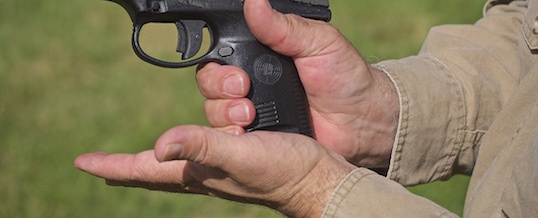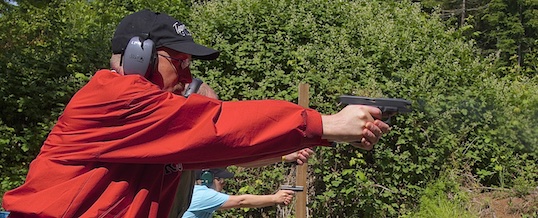
Tap-Rack is an action, not a dance. You don’t need to add moves to it.
I recently read a blog post about a trainer who got into trouble talking about the “tap-rack” methodology for clearing malfunctions. It seems this person, as many do, added a step to the procedure: “squeeze” (or some term which implied pulling the trigger.) This resulted in a virtual spanking from the internet experts, who decried that pulling the trigger was never the proper ending to a tap-rack, and that it should be “scan”, “assess”, “move”, “decide”, “bang”, or something else.
In my opinion they’re all wrong.
There is really nothing beyond tap-rack, because it’s an action — not a dance move! A dance routine always has another movement because a dance is a continuous thing; we want each move to lead naturally to the next, and we’re devoting all our energy to keeping the dance going as long as the music holds out. The tap-rack isn’t a dance move, because it has a definable start (“my gun doesn’t work”) and a definable end (the gun has been put back into a working state.)
Allow me to explain, focusing on the autoloading handgun used for personal defense.
For those just coming in, the tap-rack is a remedial action to address a malfunction that has left the gun unable to fire (usually a “click” on an empty chamber.) It is, in fact, the first step in a non-diagnostic approach to malfunction clearing because it generally fixes about 90% or more of the possible malfunctions you’ll encounter with an autoloading pistol.
The action is simple: you “tap” the magazine into place by hitting it with the heel of your support hand, then rotate the support hand over the top of the slide and “rack” it to chamber a new round. In practice this is preferably done by bringing the gun into a “high ready” or “chest ready” position where you’re strongest and most flexible.
The very notion that something needs to follow the “rack” is predicated on the mistaken idea that you’ve stopped everything to do this and that the tap-rack takes all of your attention. Once you’ve done it, the thinking seems to be, you need to re-orient yourself to “get back into the fight”; in other words, you’ve exited the attack response highway to use the rest stop of malfunction clearing, and now you need to merge back into traffic.
The reality, of course, is that’s not what’s happening at all. When a tap-rack is performed, it can (and should) be done non-cognitively — meaning that it’s an action requiring no conscious intervention in and of itself. This is important to understand, because you can perform a tap-rack while maintaining your awareness of the threat and of the incident as a whole; you can continue to assess the incident as the tap-rack is performed. The tap-rack happens independently of everything else in the incident, and most importantly when it’s done, it’s done.
This is an important point: the tap-rack isn’t something you stop to do, it’s something that you do while everything else is going on. We train (or we should train) to do the tap-rack in an automated manner rather than having to devote cognitive energy to doing it. It is parallel processing in action.
It should be becoming clear where I’m going with this: because it’s happening in parallel with everything else in the incident, and since you’re not devoting exclusive attention to it, once the tap-rack is finished it’s done; there is nothing else to do (unless it failed, in which case the stimulus of failure causes you go immediately to Step 2 of the non-diagnostic malfunction response.)
Let’s say, for instance, that someone tells you the last step of tap-rack is “assess”. If you’ve done this correctly, as a mechanical act requiring no cognitive intervention, then you’ve been assessing all along as you’ve done it. There’s no need to “assess”, because you’re already doing so — and have been doing the entire time, thus there is no need to remind you to assess.
“Move”? Again, you have the ability to determine the need to move and do so while you’re simultaneously doing the tap-rack. You don’t need to be told or be given permission to move if you need to! “Decide”? If you’ve been assessing the entire time, you’ve either made the decision what to do next or you’re gathering the information you need to make that decision; again, both are independent of the tap-rack itself. “Bang”, “squeeze”, “pull”? These all presume that firing a shot is always a proper next action, which your assessment of the situation may show you isn’t true; automatically pulling the trigger as part of the tap-rack is no more viable than automatically pulling the trigger as part of any other manipulation.
One popular addition to tap-rack is “continue”. I hope by now you’re on my logic train and already see the answer: there is no need to continue unless you put everything aside in the first place! As I’ve pointed out, there’s no need to do so because the tap-rack can be done without putting everything else on hold, and in fact really needs to be done that way if the malfunction is to be cleared efficiently.
Now your simultaneous assessment of the incident may have lead you to determine that you need to shoot after the tap-rack, and upon attempting to do so you find that the gun still doesn’t work. That stimulus of the failure to fire should put you immediately into the clear-and-reload portion of the failure procedure. The recognition of that stimulus, however, doesn’t occur unless there is a need to shoot AND the malfunction falls into that 5% or 10% of situations that the tap-rack won’t cure. Regardless, it’s a separate procedure which doesn’t necessarily automatically flow from the tap-rack.
For some reason the term “tap-rack” does sound unfinished; perhaps it’s because an odd number of components is psychologically more comforting than an even number. Three steps, I’ll concede, does feel more “finished” than just two. This is purely conjecture on my part, of course, but perhaps that’s why so many people feel a compulsion to add steps to the end.
They’re not needed: tap-rack, then get on with your life.
– Grant Cunningham
- Posted by Grant Cunningham
- On October 26, 2015



